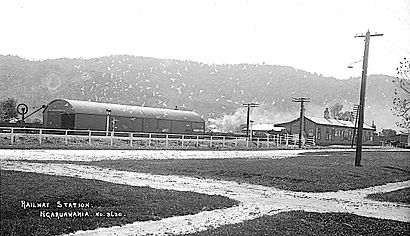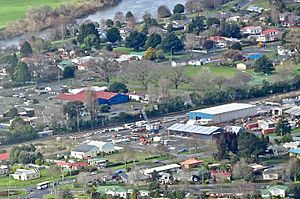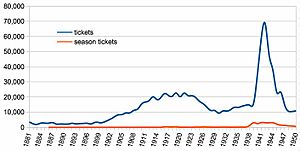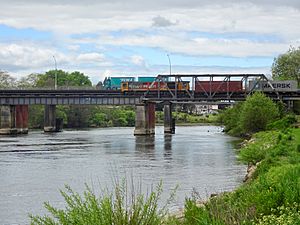Ngāruawāhia railway station facts for kids
Quick facts for kids
Ngāruawāhia railway station
|
|
|---|---|

Ngāruawāhia station, about 1910.
Alexander Turnbull Library, Wellington |
|
| Location | Ngāruawāhia New Zealand |
| Coordinates | 37°40′05.9″S 175°08′56.1″E / 37.668306°S 175.148917°E |
| Owned by | KiwiRail Network |
| Line(s) | North Island Main Trunk |
| Tracks | double track from 4 December 1938 |
| History | |
| Opened | 13 August 1877 |
| Closed | 29 July 1978 (goods), 1975 (passengers) |
| Previous names | Newcastle until 1878 |
Ngāruawāhia railway station was at the junction of the North Island Main Trunk line and its Glen Massey branch, serving Ngāruawāhia in the Waikato District of New Zealand, 74 mi (119 km) south of Auckland and 10 mi (16 km) north of Hamilton. It was opened with a special train from Auckland on Monday 13 August 1877. The next stations were Taupiri 6.5 km (4.0 mi) to the north and Horotiu 5.5 km (3.4 mi) to the south.
In 2020 reopening of the remaining platform was put forward as a COVID-19 recovery scheme, estimated to cost $15m.

Contents
History
The station opened on 13 August 1877, as Newcastle, when the line was extended 31 mi (50 km) from the previous terminus at Mercer, though the stationmaster's house was added later. It ceased to be the terminus when the line was extended to Te Awamutu on 1 July 1880. The name was changed in 1878. Two months after opening, a platform was built opposite the Delta Hotel in the town centre, though the goods shed remained to the south.
The 1902 edition of The Cyclopedia of New Zealand described the station as wooden, with an asphalt platform, goods shed, lamp and luggage rooms, a ladies' room, public waiting room, stationmaster's office and a post office. A new station was reported as open in 1915, though in 1916 the station was reported as "rearranged considerably", which seems to have been when it was moved to about half way between the hotel and the goods shed. Electric lights were installed in 1921.
Traffic grew steadily (see graph and table below). The greatest increase was at the start of World War 2, presumably consisting largely of soldiers and relatives travelling to and from Hopuhopu camp.
| year | tickets | season tickets | staff |
| 1881 | 3,535 | 2 | |
| 1882 | 2,321 | 2 | |
| 1883 | 1,960 | 2 | |
| 1884 | 2,787 | 2 | |
| 1885 | 2,783 | 2 | |
| 1886 | 2,745 | 2 | 2 |
| 1887 | 3,093 | 2 | 2 |
| 1888 | 2,131 | 2 | 3 |
| 1889 | 2,165 | 2 | 2 |
| 1890 | |||
| 1891 | 2,142 | 3 | |
| 1892 | 2,654 | 3 | |
| 1893 | 2,309 | 4 | |
| 1894 | 2,450 | 3 | |
| 1895 | 2,574 | 3 | |
| 1896 | 2,653 | 3 | |
| 1897 | 2,274 | 3 | |
| 1898 | 3,273 | 3 | |
| 1899 | 3,158 | 3 | |
| 1900 | 3,210 | 3 | |
| 1901 | |||
| 1902 | 5,442 | 3 | |
| 1903 | 6,951 | 1 | 3 |
| 1904 | 8,230 | 4 | 3 |
| 1905 | 8,487 | 16 | 3 |
| 1906 | 9,469 | 30 | 4 |
| 1907 | 9,542 | 18 | 3 |
| 1908 | 11,146 | 9 | 4 |
| 1909 | 12,053 | 24 | 5 |
| 1910 | 15,239 | 45 | 4 |
| 1911 | 16,705 | 52 | 5 |
| 1912 | 17,697 | 31 | 6 |
| 1913 | 20,164 | 37 | 8 |
| 1914 | 18,354 | 33 | |
| 1915 | 19,620 | 36 | |
| 1916 | 22,270 | 327 | |
| 1917 | 21,029 | 296 | |
| 1918 | 20,608 | 254 | |
| 1919 | 22,606 | 300 | |
| 1920 | 20,266 | 118 | |
| 1921 | 22,535 | 106 | |
| 1922 | 21,032 | 83 | |
| 1923 | 20,909 | 76 | |
| 1924 | 19,737 | 165 | |
| 1925 | 17,197 | 147 | |
| 1926 | 15,504 | 229 | |
| 1927 | 13,143 | 184 | |
| 1928 | 11,113 | 141 | |
| 1929 | 11,061 | 115 | |
| 1930 | 9,346 | 117 | |
| 1931 | 10,731 | 147 | |
| 1932 | 10,742 | 151 | |
| 1933 | 11,579 | 102 | |
| 1934 | 13,171 | 129 | |
| 1935 | 13,137 | 132 | |
| 1936 | 13,927 | 156 | |
| 1937 | 14,581 | 199 | |
| 1938 | 14,576 | 1,252 | |
| 1939 | 15,879 | 3,016 | |
| 1940 | 34,839 | 2,469 | |
| 1941 | 58,643 | 3,131 | |
| 1942 | 68,419 | 3,039 | |
| 1943 | 48,246 | 3,010 | |
| 1944 | 37,802 | 3,032 | |
| 1945 | 23,207 | 2,120 | |
| 1946 | 23,252 | 1,481 | |
| 1947 | 15,198 | 1,304 | |
| 1948 | 10,675 | 1,021 | |
| 1949 | 10,471 | 877 | |
| 1950 | 10,844 | 574 |
Waikato River Bridges
1877 road-rail bridge
Work started on a road rail bridge over the Waikato River, with three 120 ft (37 m) spans late in 1874, with pile driving started on 18 January 1875. Cylinders for the piers were delivered in 1875 and the first was put in place on 24 June 1875. The bridge was said to be near completion in April 1876, and a test train was run over it and it opened for road traffic in December 1876. However, it wasn't reported as finished until 1877, the year of a permanent way contract for the 30 miles from Mercer for £16,832. The bridge, like the station, opened for rail traffic on 13 August 1877.
Gates, controlled from the bridgekeeper's house, kept road traffic off the bridge when trains were due. Although it was planned to demolish the house in 1929, it survived until the bridge was demolished in 1968.
1931 rail bridge
In 1928 it was decided to replace the 1877 bridge, as it needed repair. The new bridge was 35 ft (11 m) downstream, had 6 spans, 3 x 117 ft (36 m) steel Pratt trusses, 2 x 38 ft (12 m) and 1 x 24 ft (7.3 m) plate girders, a total of 451 ft (137 m). It rests on concrete piers up to 70 ft (21 m) deep. It was designed by NZR, using over 253 tons of steel (or 255 tons). It was made in Britain, fabricated by A & G Price and cost £25,000. The last rivet was driven in February, the first train crossed the bridge on 13 March and by November 1931 the old bridge was being used for northbound road traffic. At that time it was expected that the old bridge would be refurbished for rail use when the track was doubled, so it was leased to the Main Highways Board.
1974 crash
21 wagons of a southbound train derailed and piled up on the northernmost truss of the bridge after an axle broke on 14 July 1974.
2002 repair
On 14 March 1998 part of train 235 hit the 1931 bridge, requiring the replacement of 2 of the trusses with 2 x 36 m (118 ft) beams in 2001/2 by McConnell Smith.
Gallery








